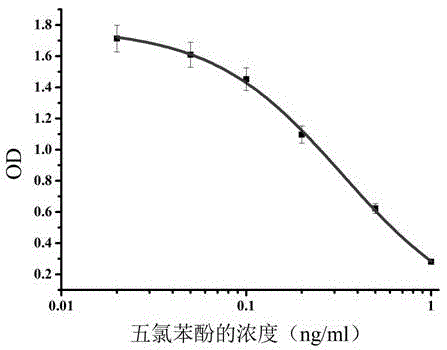Pentachlorophenol monoclonal antibody hybridoma cell strain 2C3 and application thereof
A hybridoma cell line and monoclonal antibody technology, applied in the field of food safety immunological detection, can solve the problems of high cost, inability to realize rapid sample detection, time-consuming, etc., and achieve the effect of good detection sensitivity and specificity
- Summary
- Abstract
- Description
- Claims
- Application Information
AI Technical Summary
Problems solved by technology
Method used
Image
Examples
Embodiment 1
[0018] Embodiment 1: the preparation of hybridoma cell line 2C3
[0019] (1) Synthesis of complete antigen:
[0020] Add about 100mL of acetone solvent into a 250mL round-bottomed three-neck flask, under nitrogen protection, add 3g (12.15mmol) of tetrachlorohydrodiphenol and 10g (72.5mmol) of potassium carbonate, stir to dissolve as much as possible, and dissolve 1.58g (8.1mmol) Ethyl 4-bromobutyrate was dissolved in a small amount of acetone, added dropwise to the reaction solution, and started to reflux for about 12 hours. Thin-layer liquid chromatography (TLC) detected that the reaction was complete, and the acetone solvent was removed under reduced pressure. The reactants were dissolved in 50 mL of deionized water, and then 30 mL of ethyl acetate was added, fully shaken, allowed to stand and separated, and the water phase was retained. Add dilute hydrochloric acid solution to the water phase to adjust the pH to 3, extract the water phase with ethyl acetate 50mL×2, combin...
PUM
 Login to View More
Login to View More Abstract
Description
Claims
Application Information
 Login to View More
Login to View More - R&D
- Intellectual Property
- Life Sciences
- Materials
- Tech Scout
- Unparalleled Data Quality
- Higher Quality Content
- 60% Fewer Hallucinations
Browse by: Latest US Patents, China's latest patents, Technical Efficacy Thesaurus, Application Domain, Technology Topic, Popular Technical Reports.
© 2025 PatSnap. All rights reserved.Legal|Privacy policy|Modern Slavery Act Transparency Statement|Sitemap|About US| Contact US: help@patsnap.com


